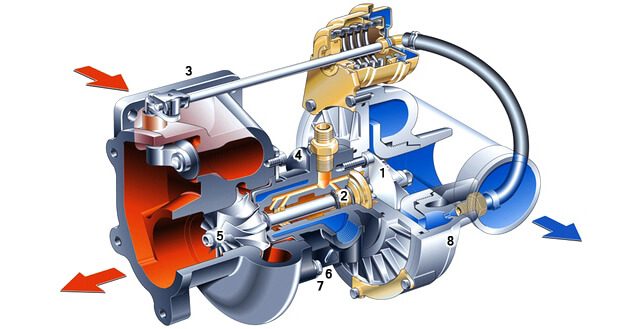
5 symptoms of turbocharger breakdown
Content
It is often said that the turbocharger failure is dead and not blowing. This funny saying of mechanics does not make the owners of cars in which the turbocharger failed - replacing the turbine usually reduces the wallet by several thousand. However, the shortcomings of this element are easy to recognize. Find out why he didn't explode before he completely dies!
What will you learn from this post?
- How to tell if a turbocharger is not working properly?
Shortly speaking
The turbocharger works in difficult conditions. On the one hand, it is heavily loaded – its rotor spins at up to 250 revolutions. rpm. On the other hand, it must cope with enormous temperatures - the exhaust gases that pass through it are heated up to several hundred degrees Celsius. Although turbines are made of durable materials and designed to last the life of the engines, engine failures are common.
However, malfunctions are preceded by obvious symptoms: a drop in engine power, blue or black smoke from the exhaust pipe, increased engine oil consumption and unusual noises (stars, howling, metal-on-metal noise).
1. Decrease in power
The most important symptom of a tube compressor failure is a noticeable drop in engine power. You will definitely notice this moment - you will feel that the car has lost accelerationand you will be surprised by the sudden silence. Permanent loss of power is most often caused by leaks between the turbocharger and the intake or exhaust system, as well as wear on this element.
There is also a signal indicating that the turbo is faulty ripple performance, i.e. periodic drops in engine power. They are usually accompanied by the inclusion of an error indicator on the dashboard. This issue refers to variable geometry turbines... This is caused by blockage of the moving rotor blades, for example, due to deposits accumulated between them.

2. Blue smoke
The color of the smoke coming from the exhaust pipe will tell you a lot about the condition of the turbocharger. If it is blue and, moreover, is accompanied by an unpleasant smell of burning, then Leakage of engine oil into the combustion chamber.... It can exit the lubrication system in various ways (for example, through damaged piston rings or valve seals). In theory, it cannot flow through the components of the turbine. It is housed in a chamber protected by metal seals which, unlike rubber hoses, are not stressed or broken. In addition, there is a huge amount of pressure in the turbocharger housing - this is what keeps it working, and this is what does not allow oil to flow out of the chamber.
The source of the leaks should be sought not so much in the turbocharger itself as in the turbocharger itself. in case of failure of the lubrication system... The problem can be a dirty DPF or EGR valve, clogged lines that carry oil through the turbine chamber, or even excess oil in the engine.
Watch the running engine!
Although the reasons are trivial, it happens that a minor malfunction in cars with a diesel unit ends in a spectacular breakdown - the so-called engine acceleration. It comes to him when so much engine oil enters the cylinders that it becomes an additional dose of fuel. The engine starts to start - it goes to higher and higher speeds, which causes an increase in turbocharging. The turbine delivers subsequent doses of air into the combustion chamber, and with them subsequent doses of ... oil, causing an even greater increase in speed. This spiral cannot be stopped. More often even turning off the ignition does not help – diesel engines are usually switched off by cutting off the fuel supply. And when that fuel becomes engine oil...
Failure of the drive in the overwhelming majority of cases results in failure of the drive unit.
You can read more about engine scatter here: Engine scatter is a crazy diesel disease. What is it and why don't you want to experience it?
3. Thirst for oil and spills.
It happens that supercharged cars "take" a little more oil - this is natural. However, if refueling is required more often than usual, take a closer look and have a trusted mechanic check the lubrication system. The turbine could be the culprit. Every trace of oil on the lines should be a concern. A lubricated turbocharger or intercooler—the radiator that lowers the temperature of the air before it enters the cylinder—is the last warning sign of a serious engine problem.
4. Black smoke
In turbocharged cars, sometimes the opposite happens - up to the cylinders there is not enough air for proper fuel combustion. This is indicated by black smoke and a drop in engine power. The problem is usually purely mechanical - occurs due to damage to the rotor.
5. Sound
Modern turbocharging systems are so quiet that many drivers only become aware of them when they start to fail and therefore run louder. Any unusual noise that the engine suddenly makes should be cause for concern, but some noises are whistling, howling or the sound of metal rubbing against metal - typical for a failed turbine... They appear when the engine is tuned to higher rpm (from about 1500 rpm) and increase with increasing load. Causes can range from leaking piping and lubrication problems, cracked housing and worn bearings, to a clogged DPF or catalytic converter.
How to avoid serious and costly turbocharger failure? Take care of proper lubrication. We have a knowledge pack for you to keep your turbo in good condition - from our blog you will learn how a turbocharger works and how to drive a turbocharged car so as not to overload the system and in our car shop .com you will find the best motor oils. Check it out - let the turbine in your car run smoothly!
unsplash.com